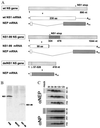Influenza A and B viruses expressing altered NS1 proteins: A vaccine approach
- PMID: 10725408
- PMCID: PMC18238
- DOI: 10.1073/pnas.070525997
Influenza A and B viruses expressing altered NS1 proteins: A vaccine approach
Abstract
We propose a rational approach to the generation of live viral vaccines: alteration of virally encoded type I IFN antagonists to attenuate virulence while retaining immunogenicity. We have explored this concept by using the influenza virus. Previously we have shown that the NS1 protein of influenza A virus possesses anti-IFN activity. We now present evidence that influenza A and B viruses encoding altered viral NS1 proteins are highly attenuated in the mouse host, yet provide protection from challenge with wild-type viruses.
Figures







Similar articles
-
Development of a live-attenuated influenza B DeltaNS1 intranasal vaccine candidate.Vaccine. 2009 May 11;27(21):2851-7. doi: 10.1016/j.vaccine.2009.02.087. Epub 2009 Mar 11. Vaccine. 2009. PMID: 19366569
-
Growth and immunogenicity of influenza viruses cultivated in Vero or MDCK cells and in embryonated chicken eggs.Dev Biol Stand. 1999;98:39-51; discussion 73-4. Dev Biol Stand. 1999. PMID: 10494958
-
Immunogenicity and protection efficacy of replication-deficient influenza A viruses with altered NS1 genes.J Virol. 2004 Dec;78(23):13037-45. doi: 10.1128/JVI.78.23.13037-13045.2004. J Virol. 2004. PMID: 15542655 Free PMC article.
-
Identification of effective constituents of influenza vaccine by immunization with plasmid DNAs encoding viral proteins.Jpn J Infect Dis. 2000 Dec;53(6):219-28. Jpn J Infect Dis. 2000. PMID: 11227019 Review.
-
Learning from our foes: a novel vaccine concept for influenza virus.Arch Virol Suppl. 1999;15:131-8. doi: 10.1007/978-3-7091-6425-9_9. Arch Virol Suppl. 1999. PMID: 10470274 Review.
Cited by
-
The Dynamic Interface of Viruses with STATs.J Virol. 2020 Oct 27;94(22):e00856-20. doi: 10.1128/JVI.00856-20. Print 2020 Oct 27. J Virol. 2020. PMID: 32847860 Free PMC article. Review.
-
Evasion of influenza A viruses from innate and adaptive immune responses.Viruses. 2012 Sep;4(9):1438-76. doi: 10.3390/v4091438. Epub 2012 Sep 3. Viruses. 2012. PMID: 23170167 Free PMC article. Review.
-
Making better influenza virus vaccines?Emerg Infect Dis. 2006 Jan;12(1):61-5. doi: 10.3201/eid1201.051043. Emerg Infect Dis. 2006. PMID: 16494719 Free PMC article. Review.
-
The role of reverse genetics in the development of vaccines against respiratory viruses.Expert Opin Biol Ther. 2005 Mar;5(3):369-80. doi: 10.1517/14712598.5.3.369. Expert Opin Biol Ther. 2005. PMID: 15833074 Free PMC article. Review.
-
Extending the cytoplasmic tail of the influenza a virus M2 protein leads to reduced virus replication in vivo but not in vitro.J Virol. 2008 Jan;82(2):1059-63. doi: 10.1128/JVI.01499-07. Epub 2007 Nov 7. J Virol. 2008. PMID: 17989186 Free PMC article.
References
-
- Maassab H F, Herlocher M L, Bryant M L. In: Vaccines. Plotkin S A, Orenstein W A, editors. Philadelphia: Saunders; 1999. pp. 909–927.
-
- Gorse G J, Belshe R B. Scand J Infect Dis. 1991;23:7–17. - PubMed
-
- García-Sastre A, Egorov A, Matassov D, Brandt S, Levy D E, Durbin J E, Palese P, Muster T. Virology. 1998;252:324–330. - PubMed
-
- Luytjes W, Krystal M, Enami M, Pavin J D, Palese P. Cell. 1989;59:1107–1113. - PubMed
Publication types
MeSH terms
Substances
LinkOut - more resources
Full Text Sources
Other Literature Sources
Medical

